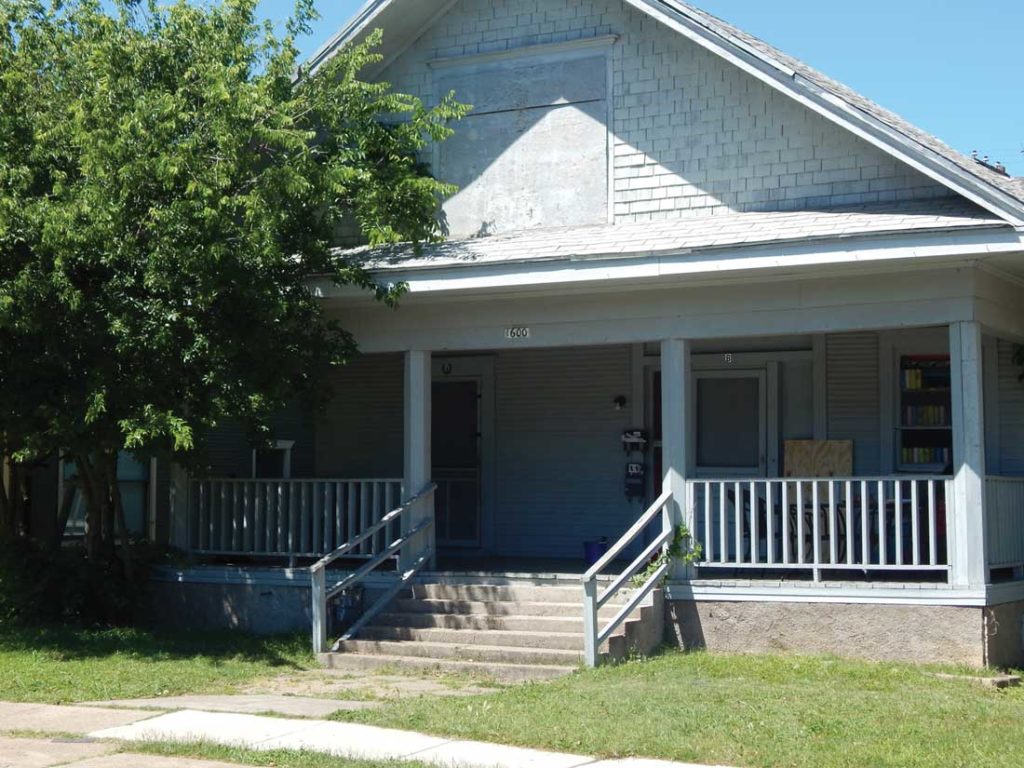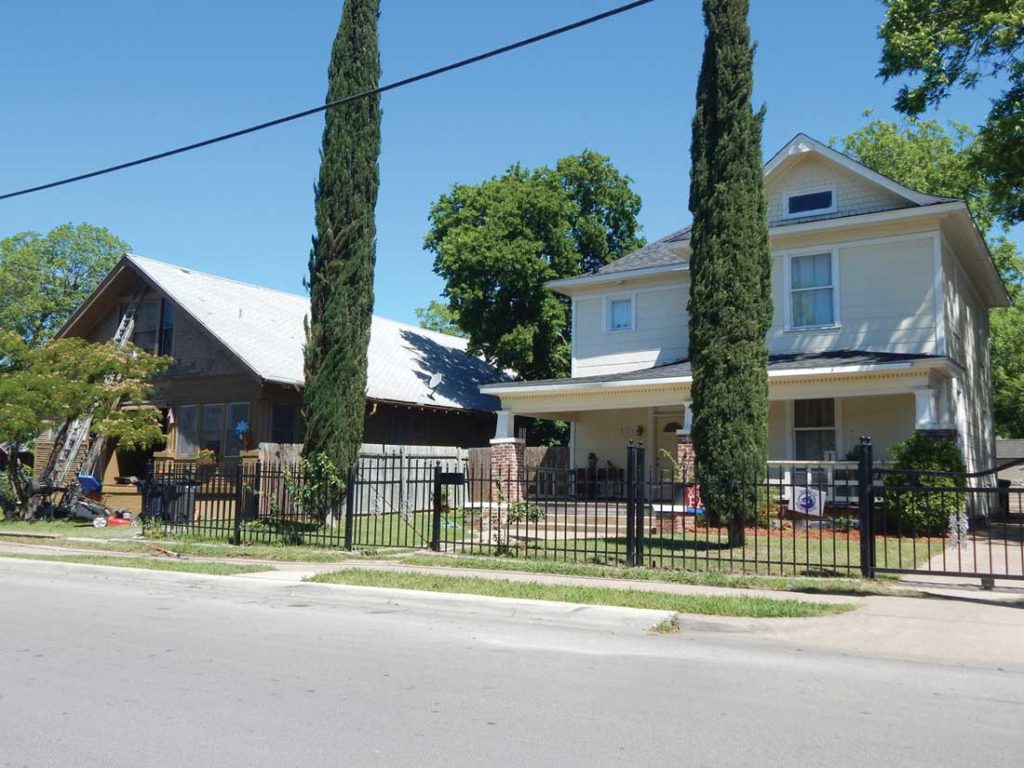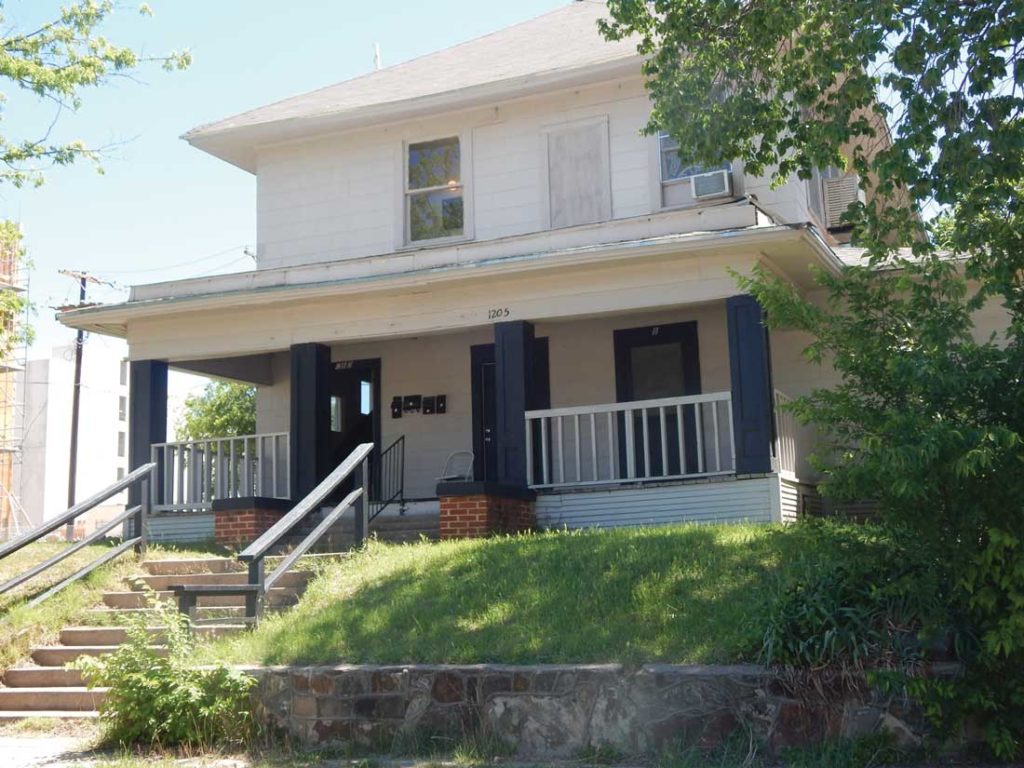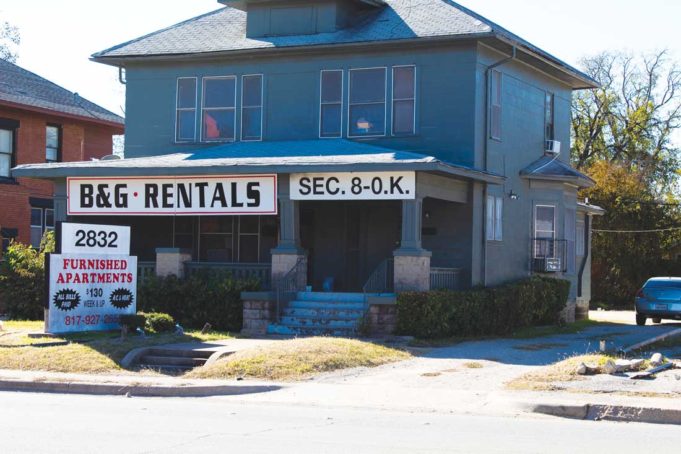Kevin Bury still remembers the screams.
“Help me! He’s beating my son!” a women yelled while running in front of Bury’s home in late 2017 in Fairmount, a historic neighborhood just south of the thriving Near Southside. In the weeks before, according to police emails, a nearby property on Washington Avenue (the home from which Bury believes the mother was fleeing) was the scene of two nonfatal drug-related shootings. Bury followed up by contacting city officials and law enforcement. The incidents were tied to a house owned by B&G Rentals, a nearly 50-year-old property management company based out of Fort Worth with around 200 properties across the city. The problems with the Washington Avenue house eventually convinced Bury to move to nearby Ryan Place with his wife and young daughter.
“B&G rentals have been an issue for many years,” a neighborhood police officer replied in an October 2017 email to Bury that he shared with us. “The same complaints over and over again don’t seem to motivate the person in charge to do a better job of screening people who rent these properties. Given the recent shootings, I will not advise officers to sit in front of the house [on] Washington to complete offense reports due to the risk of an ambush.”
Weeks later, law enforcement notified Bury that two of the most dangerous B&G tenants living on his street had been evicted. Bury said he keeps in touch with some of his former neighbors, who describe nuisance issues from B&G tenants as “getting worse” in recent months after a short lull.
“A disgusting mess” is how Bury describes some of the interiors of the handful of B&G properties he’s seen. He also believes the property managers “do the bare minimum to make the outside look acceptable. Everyone in Fairmount knows about this problem.”
In our interviews with more than a dozen Fairmount residents, we were warned early on that, while the B&G properties are a hot topic in Fairmount (covered, in part, through a private Facebook group dedicated to them), many residents are intimidated by the company or fear retaliation from B&G tenants. Several Fairmount residents we spoke with accused B&G Rentals of threatening to sue to quell accusations of lackluster property management, although B&G’s owner adamantly denies using those tactics.
Shawn Wolfe inherited B&G Rentals through a trust from her father, Hollis Glen Sloan, who died in 2007. Wolfe, who owns and manages all of B&G’s properties (including about two dozen in Fairmount), was unfazed by the ignominious title. She told us that she is working to improve the quality of her tenants while investing money into refurbishing and updating her properties in Fairmount. We saw one of those renovations firsthand. The three-bedroom abode wasn’t decked out with fancy amenities but appeared clean and it fit in with the quality level of the surrounding homes.
“I want to get along with my neighbors,” she told us. “I want to get rid of bad tenants. I don’t get anything out of having bad tenants.”
Wolfe is quick to boast about her work housing veterans and MHMR clients. She added that she does her best to evict troublemakers, but she said those efforts are often hamstrung by laws that require her to give 30 days’ notice while proving a lease violation through the Justice of the Peace Court 5, an entity with jurisdiction in the area to which she makes political contributions heavily and regularly, according to campaign filing disclosures we examined.
Outsiders might raise a curious eyebrow at complaints on the part of white property owners who live in a politically progressive and diverse neighborhood but complain about the riff-raff. Many former inmates seeking housing in B&G properties are themselves the victims of a criminal justice system that often prefers jailing black men over whites, but the B&G story, which dates back to the mid-1970s, defies knee-jerk assumptions and touches on a wide range of issues, from property rights and gentrification to neighborhood organizing and historic preservation.
*****

Fairmount resident Michael McDermott literally wrote the book on the district’s history. In Fort Worth’s Fairmount District, he richly describes the origins of the 340-acre historic area, which was built through several developments beginning in the 1880s and 1890s. Despite demolitions and ill-kept homes over the past century, 1,500 historic structures still exist in Fairmount.
“Through the 1960s and 1970s, scores of houses were lost to neglect and fire,” McDermott writes.
The Fairmount Neighborhood Association was formed in 1978 to address rising crime in the area. Speaking from his restored 109-year-old home, McDermott recounted his experience living in Fairmount, where he first moved to in 1984.
“We ducked the bullets and gunfire” back then, he said with a laugh. “The people who moved here were hearty stock. I loved the old houses here since I was a kid.”
McDermott credits the homeowners of the 1980s with saving the district from being gobbled up by the nearby Hospital District. He was part of a group of homeowners who requested and were given a spot on the National Register of Historic Places by the U.S. National Park Service in 1990.
“The first thing I heard was about this rental property owner and all the crime emitting from every home he owned,” McDermott recalled, referring to B&G founder Sloan.
Early on, McDermott became an active member of the Fairmount Neighborhood Association, for whom he has been serving as director of preservation for the past several years.
McDermott said the fronts of some B&G houses featured signs for Section 8, the federal voucher program that allows very low-income families, the elderly, and the disabled to move into private homes with the assistance of federal funds from the U.S. Department of Housing and Urban Development (HUD).
“We got the city to remove those signs,” he said.
During neighborhood association meetings in the late 1980s and early 1990s, McDermott said the addresses of homes where officers made arrests or addressed complaints were included in the police reports that were a regular feature of the meetings.
Around “80 percent of the time, it was a Sloan” property, McDermott said. “Everything Sloan did, we had to fight, fight, fight. He called us all Nazis and communists.”
Shawn rebuked McDermott’s statements, saying that many police visits were to check on distressed veterans who she said frequently did not take their prescribed medications.
McDermott, who has periodically invested in properties in and around Fairmount over the past few decades, said that while B&G Rentals is not the only rental company in Fairmount that skimps on upkeep and attracts problematic tenants, B&G has been the most pervasive problem, based on his experience.
He estimates that the Sloan family or any family investing in the 1960s or ’70s would have been able to purchase homes in poorer areas in Fort Worth for as little $1,500 each.
McDermott said he found a historic home, one of the last of its kind, in 1993 that was at risk of being torn down if it wasn’t relocated. With the help of funds from his father, McDermott approached Sloan with the intent of buying a double lot on College Avenue from him. The double lot eventually became the historic home’s new address.
“I wasn’t going to go alone, so I took a friend,” McDermott said, referring to Sloan’s public perception at the time of being brash. Sloan, McDermott continued, was “hard to deal with. I wanted a witness.”
With his good friend Rose Lynn Scott in tow, McDermott walked into B&G Rentals’ Hemphill Street headquarters.
“Mr. Sloan was sitting at his desk in a vinyl 1970s-era jacket,” McDermott recalled. “He had a big scar on his bare chest and a gold chain. A young man was in the corner, wearing a wife beater and lifting weights. He had all these muscle magazines spread out around him.”
The way Sloan handled business and his tenants reminded McDermott of the miserly Mr. Potter from the iconic 1946 movie It’s a Wonderful Life.
“I shook hands with him, walked out, and immediately wiped my hands,” McDermott said. “I didn’t care to do business with him.”
During our interview, McDermott took one of us on a tour of the Fairmount area, where he pointed out a handful of B&G properties. Most of them have chain-link fences and ill-kept lawns out front and show signs of general dilapidation.
B&G does “just enough to stay within the law,” McDermott alleges. “They used to come in with a chainsaw and cut down anything that needed maintaining, denuded the property of any living plant life.”
One large B&G multifamily home on South Adams Street that he pointed out is valued at $70,000, according to the Tarrant Appraisal District (TAD), while a neighboring privately owned home is listed at close to $300,000. Lower property values mean lower property taxes. Using the county’s online calculator, we found that B&G Rentals pays around $2,000 annually in property taxes for that one home, which holds several tenants. Another B&G abode on nearby Alston Avenue is similarly valued at $72,615.
Using the South Adams Street home as an example, we reached out to Mary McCoy, an administrator with TAD to learn more about how the property could be priced at a fraction of the neighboring property values.
“The property you asked about is a multifamily dwelling that is appraised not as a single-family dwelling but as a residential rental structure,” she said in an email.
As a single-family dwelling, she continued, the house would reasonably be expected to be appraised higher, but the classification as residential rental structure in that area, added with TAD data on such classifications in that area, indicate a potential lower value.
“It is not uncommon that residential rental units in that area are not maintained as well as owner-occupied residential structures,” she said.
Several residents we spoke with believe B&G Rentals uses a small army of lawyers, presumably working through TAD, to keep the home values down. McCoy said that B&G does not use a law firm to work as an intermediary between B&G Rentals and TAD.
“We are unaware of any law firm representing this property owner,” McCoy said.
Wolfe told us the property tax bill for all of her rentals increased by $72,000 total last year, meaning that she too is impacted by rising property taxes.
Carey Rose is left with mixed feelings after selling her home in Fairmount due to what she said are unaffordable property taxes. Rose and her husband recently purchased two homes in the area with the intention of renovating or living in them.
“I took a chance on a home,” she said. “We saw it rise from the dead.”
When the couple projected how much they would have to pay in property taxes per year ($10,000), they made the difficult decision to sell. Rose ran the numbers. The taxes would cut too deeply into their retirement plans.
Property taxes aren’t “going to affect Shawn Wolfe and B&G properties,” Rose alleges, noticeably upset. “They let those properties [deteriorate], and they’re paying pennies on the dollars in comparison to everyone else. It makes no sense that someone should be taxed at a lesser rate when [their rental homes] are income-producing properties. I’m putting money into homes to restore them the right way, by the historic guidelines.”
Over the past 20 years, Rose said the neighborhood has petitioned the city repeatedly to address B&G Rentals, but without a legal team and political influence, Rose said, those efforts failed.
“People are starting to give up” on the idea of things getting better, she said.
*****

Police data from 2016 through early 2017 paints a picture of consistent calls to five Fairmount-based B&G properties we requested records on. Over 15 months, those homes had a total of 40 police calls for incidents of domestic disturbance, home invasions, theft, or ambulances to treat paranoid or disoriented residents. We reached out to the Fort Worth police department for comment on overall crime in the area, but we were told that since the answer would require “speculation” on the part of a neighborhood police officer, there would be no comment.
Over that same period, most B&G homes were free of code violations, according to city code compliance records. The few citations for overgrown lawns and broken windows have since been dealt with.
The incidents of crime and violence tied to B&G Rentals have lessened over the years, with the worst period being the early 2000s, McDermott believes.
Wolfe said that it was the early 1980s when her company began accepting Section 8 housing. She began work with the Fort Worth Housing Solutions (FWHS), an agency that administers funds from HUD.
“Those programs were initially supposed to last five years, [long enough for] those people to make it without assistance,” she said, “but now they can stay on those programs their whole lives.”
The housing units selected by the family, according to HUD’s website, “must meet an acceptable level of health and safety before” the federal funds are given directly to landlords.
Of the 18 homes within Fairmount that are owned by B&G Rentals, according to TAD’s website, six units are currently participating in the Housing Choice Voucher program, according to Patricia Campbell, HUD regional public affairs officer, who spoke with us over the phone and through emails. HUD funds but does not manage the voucher program directly. The government agency funds housing authorities like Fort Worth Housing Solutions, and those agencies administer the voucher funds under government guidelines. Of those six B&G properties, five had vouchers managed through FWHS while one is overseen by Tarrant County Housing Assistance. HUD relies on local entities like FWHS and Tarrant County Housing Assistance to ensure units are regularly inspected. Campbell provided recent dates when all of the units passed inspections along with the comprehensive inspection checklist used by Tarrant County Housing Assistance.
We chatted with one B&G Rentals tenant in Fairmount. The young man said he likes the section of the home he lives in and the neighborhood but complained about water leaking from inside the walls. B&G Rentals, he said, has not answered his months of complaints. He wasn’t sure how the three other tenants who live in the partitioned home felt about the property owners.
Six of the nine tenants who are assisted by FWHS in a Fairmount-based B&G Rentals property “were previously homeless,” and they were referred by local nonprofits and governmental agencies, Campbell said.
“There is a real shortage of affordable housing,” she said over the phone.
Indeed, her assertion is backed up by city data. According to a study conducted by the city, 35 percent of Fort Worth families cannot afford the fair market rent of a two-bedroom apartment. The average price of an apartment in North Texas is now a little more than $1,000 a month. Apartments and homes in Fairmount rent from $600 to $2,500 per month, according to public listings. Wolfe said her single-family homes rent for about $1,800 per month while duplexes generally run for a little over $1,250. Tenants receiving rental assistance through the federal housing voucher program pay 30 percent of their income with the rest being picked by HUD. Wolfe said her HUD housing units, which are generally split into three to four units, rent monthly for $750 to $900 per apartment.
Government-subsidized housing is often disproportionately blamed for neighborhood blight, Campbell said, adding that HUD and governmental groups like FWHS work to ensure that the properties are well kept and safe. As for Fairmount residents who are miffed that federal vouchers are bringing low-income residents into an increasingly affluent part of town, the rental assistance program makes no distinction as to where the vouchers can be used. That decision is up to landlords who participate in the program.
“The purpose is to allow people with rental assistance to have a choice in the community that they want to live in,” Campbell said. “They can move to communities that they feel are beneficial to them and their families. It gives them access to the type of community they want to live in.”
Five years ago, B&G Rentals began working with veterans, the homeless, and MHMR clients, Wolfe told us.
“We did that because we drove down [nearby] Lancaster [Avenue] and saw so many homeless people, and I learned [there was] a program to get them off the streets,” Wolfe said, “so we pledged apartments to them. Case workers were keeping an eye on them.”
Catherine Carlton, MHMR of Tarrant County chief of staff, confirmed in an email that her agency works with B&G Rentals.
“Our role is to help people with very little resources find a place to sleep,” she said.
Wolfe acknowledged that not all her tenants make for ideal neighbors.
“Yes, we get some bad eggs now and then,” Wolfe said, “but remember that all these people have gone through the federal government and have been deemed worthy of having an apartment. And when they turn out to be bad tenants, well, we evict them.”
Wolfe said that she has evicted “hundreds” of tenants from her buildings over the years, including “plenty” from Fairmount.
“There is a group of teens running around and breaking into vacant apartments, tagging houses and drinking beer and whiskey,” she said. “I board up my stuff from the inside while I’m fixing apartments up, and I’ve had vagrants. But you can’t blame a landlord for squatters [that the landlord doesn’t] know about until you tell them about the problem.”
Tenants enjoy a wide range of protections under Texas law, some of which make evictions a burdensome process for landlords. According to the State Attorney General’s website, evictions are permissible if renters fail to pay rent on time, threaten the safety of the landlord, or intentionally damage the property. Tenants have the right to demand repairs that affect their “physical health and safety” as long as the cost of the repairs does not exceed $10,000. Evictions and demands for repairs are handled through Justice of the Peace courts.
Wolfe said she feels caught in the middle. On one hand, she wants to provide housing options for low-income individuals, families, and veterans. On the other hand, she sees Fairmount as unwelcoming to federally subsidized rental homes. Because of the public and online backlash, she said she plans to phase out the voucher program for her Fairmount homes.
*****

Despite decades of friction between B&G Rentals and dozens of Fairmount residents and despite the documented concerns on the part of the Fort Worth police department, Wolfe appeared genuinely surprised that her company’s public image was anything but positive.
“When you called,” she told us, “I thought you were going to say congrats for my work with MHMR. I didn’t know you were calling me to tell me that people hate me and think I’ll retaliate against them.”
In what she hopes will be a long-term détente with the Fairmount neighborhood, Wolfe said she is repairing HUD-funded units as they become vacant and renting them only to non-Section 8 renters. Wolfe was overseeing the final renovations of her rental home on Hurley Avenue when one of us dropped by. The home, she said, just underwent a $30,000 sprucing up.
“These are the original,” she said, pointing to two doors that were refitted as sliding models. “I couldn’t throw them away. People want an open-concept” floor plan. The home, she said, will likely be rented to a “corporate” renter, meaning any business that needs to bring in professionals for one- to two-year stints. She said she has to be mindful of what the neighborhood will deem “acceptable.”
There’s catching up to do, she admitted. Many of her homes haven’t been updated in decades. That status quo looks comparatively shabby to area homes that are undergoing gutting and expensive refurbishing. Without stating it explicitly, Wolfe seemed aware that the management of her family’s legacy could not be left on autopilot.
“This is my livelihood, my retirement,” she said. “I want to leave it to the next generation, to my family, but the neighbors will always be angry about something because they just don’t want renters there. They want homeowners.”
City councilmember Ann Zadeh, whose district includes Fairmount, said she hasn’t heard of an “uptick in calls” and complaints regarding B&G Rentals units.
McDermott and his husband have made Fairmount their final home. McDermott, a professional landscaper, loves the politically progressive bastion for its diversity and quirkiness. Here, he said, neighbors still gather on porches and watch out for one another.
Diversity means more than color, he said. Economic diversity, he added, is a feature of the neighborhood that needs to be actively fought for. He welcomes Section 8 housing as one way to achieve that, but the patriarch of B&M Rentals set a bad precedent that lingers to this day, he said.
“We moved here for the diversity,” McDermott said. “We want [the homes here] to be clean and well run. Unfortunately, Sloan’s intention was to make as much money as he could while doing as little as he could.”













We have lived down the street from one of their properties in Fairmount for 19 years. Always problems with the tenants there and the house looks horrible, like all of their other properties. City of Fort Worth has known about this problem for a long time and hasn’t moved against them like they have the landlords located off of Cherry Lane over the past few years. Time for the city and county to step up and protect the ACTUAL taxpayers of Fort Worth.
NIMBY at it’s finest. Join the club.
Same thing is going on in my Marine Creek neighborhood. More and more homes are being purchased as rentals. And of course the renters rarely care for the yard, won’t pick up trash in their yard, pick up after their dogs, bring their trash cans in, etc.
We have thought of moving, but where to? I remember when I lived in SW Fort Worth – off Hulen, Was a great, desirable place to live. Now, not so much.
It’s just what it is! I have renters in my neighborhood and they are bad everywhere. Everyone can’t afford to pay for a home and the divide is getting bigger, the haves and have nots. I don’t know what I would do if I had to rent.
The same things happens in all neighborhoods and it’s becoming more and more like the Haves and Have Nots. What are people suppose to do, sleep under the BRIDGE.
I love my 90yo house in Fairmount, but the residents are so sanctimonious. Our neighborhood FB group is full of every progressive opinion you can imagine and hardly can tolerate an opposing view, but when it comes to their own neighborhood, all that diversity, peace and love goes away and they are as conservative as Archie Bunker.
Every day on Fairmount FB, “Unknown black man looked in my trash cans.” 26 responses – “Better call it in!” We all celebrate the middle-aged (and more importantly, middle class) white dude in a dress riding his bike around the neighborhood, but god forbid an actual minority comes to the door – probably stealing packages! Ah, well. Hypocrisy makes the world go round.
And don’t even get me started on the historical architecture Nazis. Their authoritarian impulses to prevent residents from doing anything to their own property, because it might damage the “history” of some of the worst-built homes in Fort Worth, rival any good Stalinist.
Wow, angry much? Why don’t you just move already then?
Having lived in Fairmount growing up, and living here now after a fourteen year gap, I’ll take askance with a few things you mentioned.
This area was, as described in the article, “dodging bullets and gunshots”. It was bad. To the point where my parents always shredded the mail, because people would rifle through the trash cans of nicer homes (read: non-dilapidated), hoping for a credit card or social security number (back then, they were printed on the bills).
Now it has a lot of break-ins, BECAUSE there are things of actual value here now. There have been at least 30 packages stolen and six to ten cars rifled through in the past year. Because the neighborhood makes each other aware of it on the Facebook group, it does help – I’ve seen a dozen returned animals in that same time span. Side note – growing up here, there was a chance if you had a large dog and it escaped, a neighbor would shoot it out of fear of it being a feral street dog. There was nothing, absolutely nothing like the communication network we have now, and it was every block itself.
All that being said, there are sanctimonious attitudes and behaviors here – but it’s mostly from those who come here from different backgrounds/areas, who just haven’t had exposure to minorities coming to the door, or being in a neighborhood where that happens. I lived in Old East Dallas for years as well, I had an innate distrust of ANYONE walking up to my door for the longest time.
I guess this is a long-winded way it saying it’s a vastly healthier neighborhood than it was in the past, even with it’s quirks and flaws!
Most “progressives” are intolerant. Once you get to know them.
Denison texas will soon have Dallas persons coming buying up homes with this small community and it’s 20 something population . It will be hard for the residents to be in. There own town it will be to expensive to live here. But the council and mayor doesn’t mind. Just the cash thanks Al.